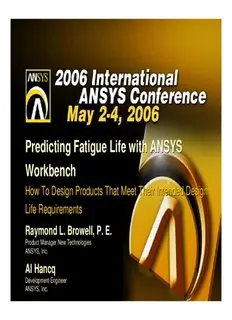
Predicting Fatigue Life with ANSYS Workbench Predicting Fatigue PDF
Preview Predicting Fatigue Life with ANSYS Workbench Predicting Fatigue
PPrreeddiiccttiinngg FFaattiigguuee LLiiffee wwiitthh AANNSSYYSS WWoorrkkbbeenncchh HHooww TToo DDeessiiggnn PPrroodduuccttss TThhaatt MMeeeett TThheeiirr IInntteennddeedd DDeessiiggnn LLiiffee RReeqquuiirreemmeennttss Raymond L. Browell, P. E. Product Manager New Technologies ANSYS, Inc. Al Hancq Development Engineer ANSYS, Inc. ©2006 ANSYS, Inc. ANSYS, Inc. Proprietary Fatigue Agenda • General Fatigue Review • Fatigue Analysis in Workbench • Working with Legacy Models • Optimization with Fatigue • Fatigue Within Workbench Fits Into Everyone’s Process! • Questions and Answers ©2006 ANSYS, Inc. ANSYS, Inc. Proprietary General Fatigue Review • Why Fatigue Analysis? – While many parts may work well initially, they often fail in service due to fatigue failure caused by repeated cyclic loading – In practice, loads significantly below static limits can cause failure if the load is repeated sufficient times – Characterizing the capability of a material to survive the many cycles a component may experience during its lifetime is the aim of fatigue analysis ©2006 ANSYS, Inc. ANSYS, Inc. Proprietary General Fatigue Review • Common Decisions Fatigue Analysis Type for Fatigue Analysis – Fatigue Analysis Loading Type Type – Loading Type Mean Stress Effects – Mean Stress Effects – Multiaxial Stress Correction Multiaxial Stress Correction – Fatigue Modification Factor Fatigue Modifications ©2006 ANSYS, Inc. ANSYS, Inc. Proprietary General Fatigue Review • Fatigue Analysis Types – Strain Life (Available in ANSYS Fatigue Module) – Stress Life (Available in ANSYS Fatigue Module) – Fracture Mechanics ©2006 ANSYS, Inc. ANSYS, Inc. Proprietary General Fatigue Review • Strain Life – Strain can be directly measured and has been shown to be an excellent quantity for characterizing low-cycle fatigue – Strain Life is typically concerned with crack initiation – In terms of cycles, Strain Life typically deals with a relatively low number of cycles and therefore addresses Low Cycle Fatigue (LCF), but works with high numbers of cycles as well – Low Cycle Fatigue usually refers to fewer than 105 (100,000) cycles – The Strain Life approach is widely used at present ©2006 ANSYS, Inc. ANSYS, Inc. Proprietary General Fatigue Review • Strain Life The Strain Life Relation equation The two cyclic stress-strain parameters is shown below: are part of the equation below: Δε σ' ( ) ( ) Δσ ⎛Δσ ⎞1/n' = f 2N b +ε' 2N c Δε = +2 ⎜ ⎟ 2 E f f f E ⎜ K' ⎟ ⎝ ⎠ Δε = Total Strain Amplitude σ' = Fatigue Strength Coefficient f 2 B = Fatigue Strength Exponent Δσ = 2 x the Stress Amplitude (Basquin’s Exponent) E = Modulus of Elasticity ε' f = Fatigue Ductility Coefficient N = Number of Cycles to Failure f C = Fatigue Ductility Exponent 2N = Number of Reversals to Failure f K' = Cyclic Strength Coefficient n' = Cyclic Strain Hardening Exponent ©2006 ANSYS, Inc. ANSYS, Inc. Proprietary General Fatigue Review • Strain Life – For Strain Life, the total strain (elastic + plastic) is the required input – But, running an FE analysis to determine the total response can be very expensive and wasteful, especially if the nominal response of the structure is elastic – So, an accepted approach is to assume a nominally elastic response and then make use of Neuber’s equation to relate local stress/strain to nominal stress/strain at a stress concentration location ©2006 ANSYS, Inc. ANSYS, Inc. Proprietary General Fatigue Review • Strain Life To relate strain to stress we use Neuber’s Rule, which is shown below: 2 εσ = K e S t ε = Local (Total) Strain σ = Local Stress K = Elastic Stress Concentration Factor t e = Nominal Elastic Strain S = Nominal Elastic Stress ©2006 ANSYS, Inc. ANSYS, Inc. Proprietary General Fatigue Review • Strain Life – Simultaneously solving Neuber’s equation along with cyclic strain equation, we can calculate the local stress/strains (including plastic response) given only elastic input – Note that this calculation is nonlinear and is solved via iterative methods – ANSYS fatigue uses a value of 1 for K , assuming t that the mesh is refined enough to capture any stress concentration effects • Note: This K is not be confused with the Stress t Reduction Factor option which is typically used in Stress life analysis to account for things such as reliability and size effects ©2006 ANSYS, Inc. ANSYS, Inc. Proprietary
